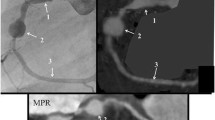Abstract
Background
After childhood Kawasaki syndrome (KS) the coronary arteries undergo a lifelong dynamic pathological change, and follow-up coronary artery imaging is essential. At present, conventional coronary catheterization (CCC) and angiography is still regarded as the gold standard. Less-invasive methods such as multidetector CT angiography (MDCT-A) and MRI have been used sporadically.
Objective
To compare the diagnostic quality of MDCT-A and MRI with that of CCC for coronary imaging in a group of patients with coronary artery pathology after childhood KS.
Materials and methods
A total of 16 patients (aged 5–27 years) underwent CCC and 16-row MDCT-A and 14 patients MRI (1.5 T).
Results
There was 100% agreement between MDCT-A and CCC in the detection of coronary aneurysms and stenoses. MDCT-A was superior for the visualization of calcified lesions. MRI and CCC showed 93% agreement for the detection of aneurysms. Visualization of coronary artery stenoses was difficult using MRI—one stenosis was missed.
Conclusion
MDCT-A has excellent correlation with CCC regarding all changes affecting the coronary arteries in the follow-up of childhood KS. In comparison to MDCT-A and CCC, MRI is less precise in the detection of stenotic lesions. Due to its high image quality and ease of performance MDCT-A should be the primary diagnostic modality in patients following childhood KS.




Similar content being viewed by others
References
Kawasaki T (1967) Acute febrile mucocutaneous syndrome with lymphoid involvement with specific desquamation of the fingers and toes in children. Arerugi 16:178–222
Kato H (1996) Long term consequences of Kawasaki disease. Circulation 94:1379–1385
Newburger JW, Takahashi M, Gerber MA et al (2004) Diagnosis, treatment, and long-term management of Kawasaki disease: a statement for health professionals from the Committee on Rheumatic Fever, Endocarditis and Kawasaki Disease, Council on Cardiovascular Disease in the Young, American Heart Association. Circulation 110:2747–2771
Goo HW, Park IS, Ko JK et al (2006) Coronary CT angiography and MR angiography of Kawasaki disease. Pediatr Radiol 36:697–705
Kanamaru H, Sato Y, Takayama T et al (2005) Assessment of coronary artery abnormalities by multislice spiral computed tomography in adolescents and young adults with Kawasaki disease. Am J Cardiol 95:522–525
Budoff MJ, Achenbach S, Duerinckx A (2003) Clinical utility of computed tomography and magnetic resonance techniques for noninvasive coronary angiography. J Am Coll Cardiol 42:1867–1878
Sohn S, Kim HS, Lee SW (2004) Multidetector row computed tomography for follow-up of patients with coronary artery aneurysms due to Kawasaki disease. Pediatr Cardiol 25:35–39
Greil GF, Stuber M, Botnar RM et al (2002) Coronary magnetic resonance angiography in adolescents and young adults with kawasaki disease. Circulation 105:908–911
Flacke S, Setser RM, Barger P et al (2000) Coronary aneurysms in Kawasaki’s disease detected by magnetic resonance coronary angiography. Circulation 101:E156–157
Mavrogeni S, Papadopoulos G, Douskou M et al (2004) Magnetic resonance angiography is equivalent to X-ray coronary angiography for the evaluation of coronary arteries in Kawasaki disease. J Am Coll Cardiol 43:649–652
Brix G, Lechel U, Veit R et al (2004) Assessment of a theoretical formalism for dose estimation in CT: an anthropomorphic phantom study. Eur Radiol 14:1275–1284
Onouchi Z, Hamaoka K, Sakata K et al (2005) Long-term changes in coronary artery aneurysms in patients with Kawasaki disease: comparison of therapeutic regimens. Circ J 69:265–272
Chu WC, Mok GC, Lam WW et al (2006) Assessment of coronary artery aneurysms in paediatric patients with Kawasaki disease by multidetector row CT angiography: feasibility and comparison with 2D echocardiography. Pediatr Radiol 36:1148–1153
Blobel J, Baartman H, Rogalla P et al (2003) Spatial and temporal resolution with 16-slice computed tomography for cardiac imaging. Rofo 175:1264–1271
Thompson BH, Stanford W (2005) Update on using coronary calcium screening by computed tomography to measure risk for coronary heart disease. Int J Cardiovasc Imaging 21:39–53
Achenbach S, Ulzheimer S, Baum U et al (2000) Noninvasive coronary angiography by retrospectively ECG-gated multislice spiral CT. Circulation 102:2823–2828
Pannu HK, Flohr TG, Corl FM et al (2003) Current concepts in multi-detector row CT evaluation of the coronary arteries: principles, techniques, and anatomy. Radiographics 23 Spec No:S111–S125
Frush DP, Yoshizumi T (2006) Conventional and CT angiography in children: dosimetry and dose comparisons. Pediatr Radiol 36:154–158
Zanzonico P, Rothenberg LN, Strauss HW (2006) Radiation exposure of computed tomography and direct intracoronary angiography: risk has its reward. J Am Coll Cardiol 47:1846–1849
Delhaye D, Remy-Jardin M, Salem R et al (2007) Coronary imaging quality in routine ECG-gated multidetector CT examinations of the entire thorax: preliminary experience with a 64-slice CT system in 133 patients. Eur Radiol 17:902–910
Kleinerman RA (2006) Cancer risks following diagnostic and therapeutic radiation exposure in children. Pediatr Radiol 36 [Suppl 14]:121–125
Acknowledgements
The authors acknowledge Toshiba and Siemens for providing imaging assistance and special on-site training. Patient I.E. was referred by Dr. M. Freund (UMC Utrecht, The Netherlands) and Dr. O. Krogmann (Duisburg Paediatric Heart Centre, Germany). Dr. Freund also kindly provided recent coronary angiograms of the patient. The MRI examinations were performed by Mrs. S. Yubai (RT) and Mrs. K. Knauer (RT) with enthusiasm and excellent patient care. The authors are very grateful to Dipl. Ing Mews (Toshiba) and Dipl. Ing. Knoch (University Heidelberg) for calculation of the effective radiation doses.
Author information
Authors and Affiliations
Corresponding author
Additional information
Raoul Arnold and Sebastian Ley contributed equally to the work reported here.
Rights and permissions
About this article
Cite this article
Arnold, R., Ley, S., Ley-Zaporozhan, J. et al. Visualization of coronary arteries in patients after childhood Kawasaki syndrome: value of multidetector CT and MR imaging in comparison to conventional coronary catheterization. Pediatr Radiol 37, 998–1006 (2007). https://doi.org/10.1007/s00247-007-0566-2
Received:
Revised:
Accepted:
Published:
Issue Date:
DOI: https://doi.org/10.1007/s00247-007-0566-2




